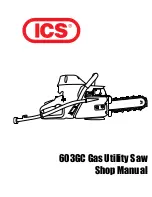
6
EN
• Keep the saw blade and the clamping surface
for the clamps clean.
• The saw blade flange must always be
mounted with the notch tightened towards the
saw blade.
• Check that all tensioning devices and locks
are secure and that no part has too much play
in it.
• Never just use your hands for sawing.
• Always press the piece of work firmly against
the stop, so that it cannot tilt or turn while
sawing. No impurities must gather underneath
the piece of work being sawn.
• Make sure that the piece of work cannot move
after being sawn, for example because it is not
completely supported by the surface of the
machine.
• For sawing pieces of work that are not
supported by the full surface, use some
padding or another machine.
• Replace any worn-out table inserts.
• Only use saw blades recommended by the
manufacturer (EN-847-1).
• Never use HS (High Speed) saw blades.
• Check that the sawn off bits can be removed
sideways from the saw blade, otherwise they
can get caught on the blade and flung about.
• Never saw more than one piece of work at the
same time.
• Be extremely careful when sawing large, very
small or awkward pieces of work.
• Be careful when sawing double mitre joints.
• Use additional supports (tables, sheer-legs
and the like) for long pieces of work that can
tip over and topple off the machine if they are
not properly secured.
• Never use the machine to saw pieces of work
that are so small that they cannot be secured
safely.
• When sawing profile sections the work must
be carried out such that the piece of work
cannot slide away and the saw blade cannot
become jammed. A profiled piece of work must
lie flat or be held in place by an attachment so
that toppling or sliding during the work is
prevented.
• Round pieces of work such as tubes must be
well secured, otherwise these can revolve and
the danger exists that the saw blade catches
in them. Always keep the piece of work on the
table and against the stop using a suitable
accessory or attachment.
• Make sure that the piece of work does not
have any nails or other foreign objects in it.
User safety
• Make sure you have a clean and tidy working
environment.
• Make sure the working environment is well lit.
• The user of the machine must be instructed in
the use, adjustment and operation of the
machine.
• Use a dust mask or dust hood to prevent the
inhalation of (harmful) dust.
• Wear gloves when you exchange the saw
blade or when rough material is to be sawn. It
is best to keep saw blades in a separate
holder to prevent anyone getting hurt.
• When the machine is equipped with a laser,
this may not be replaced by a different type of
laser. Repairs may only be carried out by the
laser manufacturer or a recognised specialist.
• The operator should wear ear protectors to
reduce any damage to hearing.
• To prevent accidents occurring by the
accidental switching on of the machine, the
plug must always be pulled out of the socket
before adjustment of the stop or the saw head
is carried out, when changing blades or
accessories, and when maintaining the
machine.
• To prevent electric shocks, when plugging the
plug into the socket the metal pins must not be
touched in any way whatsoever.
• Never use the cord to pull the plug out of the
socket. Keep the cord away from oil, heat and
sharp objects.
• Never apply a cleaning or lubrication agent to
a saw blade that is still revolving.
• To prevent fires, never use the machine in the
vicinity of flammable liquids, vapours or gases.
• Always use original accessories: others may
cause wounding.
• Always choose the right saw blade in relation
to the material to be sawn.
• Ensure that during operation, the swinging
guard functions properly. It must move freely
and be able to close by itself. It should never
be jammed in the open position.
• Do not work with material containing asbestos.
• Protect the saw blade from strikes and shocks.
Do not apply side pressure to the saw blade.
Transport
Before all work on the machine, pull the
mains plug.
Check that all locks and tensioning devices are
secure:
Summary of Contents for FKZ-255S
Page 2: ...4 1 5 11 7 8 3 2 6 9 Fig 1 17 21 10 23 22 16 13 12 15 14 Fig 2 ...
Page 3: ...19 20 18 Fig 3 Fig 4 ...
Page 117: ...117 ...
Page 119: ...119 Artikel MSM 1021 Model FKZ 255S Versie 050210 1 Exploded view ...
Page 120: ... 2010 Ferm B V ...







































